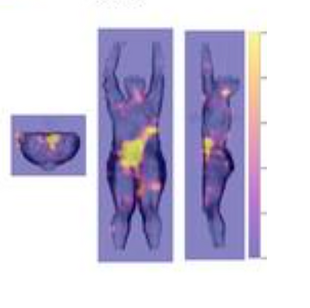Type 2 diabetes can be diagnosed with a whole-body magnetic resonance imaging (MRI) scan. This is shown by a current study by researchers from the German Center for Diabetes Research, the Institute of Diabetes Research and Metabolic Diseases of Helmholtz Zentrum München at the University of Tübingen, the Max Planck Institute for Intelligent Systems and Tübingen University Hospital. They used deep learning methods* and data from more than 2000 MRIs to identify patients with (pre-) diabetes. The results have now been published in the journal JCI Insight.
Being overweight and having a lot of body fat increase the risk of diabetes. However, not every overweight person also develops the disease. The decisive factor is where the fat is stored in the body. If fat is stored under the skin, it is less harmful than fat in deeper areas of the abdomen (known as visceral fat). How fat is distributed throughout the body can be easily visualized with whole-body magnetic resonance imaging. "We have now investigated whether type 2 diabetes could also be diagnosed on the basis of certain patterns of body fat distribution using MRI," said last author Prof. Robert Wagner, explaining the researchers' approach.
Deep learning trained with over 2000 MRI scans
To detect such patterns, the researchers used artificial intelligence (AI). They trained deep learning (machine learning) networks with whole-body MRI scans of 2,000 people who had also undergone screening with the oral glucose tolerance test (abbreviated OGTT). The OGTT can screen for impaired glucose metabolism and diagnose diabetes. This is how the AI learned to detect diabetes.
Lower abdominal fat accumulation an important indicator of diabetes pathogenesis
"An analysis of the model results showed that fat accumulation in the lower abdomen plays a crucial role in diabetes detection," Wagner said. Further additional analysis also showed that a proportion of people with prediabetes, as well as people with a diabetes subtype that can lead to kidney disease, can also be identified via MRI scans.
The researchers are now working to decipher the biological regulation of body fat distribution. One goal is to identify the causes of diabetes through new methods such as the use of AI in order to find better preventive and therapeutic options.
*Deep learning is a special method from the field of machine learning with artificial neural networks (ANN) and thus also a sub-area of artificial intelligence (AI). Deep learning is particularly suitable when there is a lot of unstructured data – such as images and scans. In order to teach deep learning algorithms to correctly evaluate images and predict diagnoses, they are trained on annotated (labeled) data.
Original publication
Dietz et al.: Diabetes detection from whole-body magnetic resonance imaging using deep learning. JCI Insight, DOI: doi.org/10.1172/jci.insight.146999

